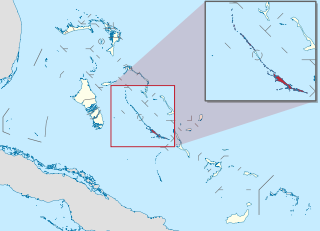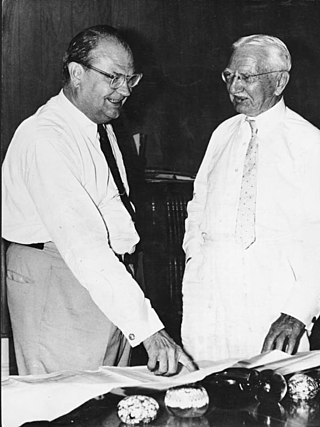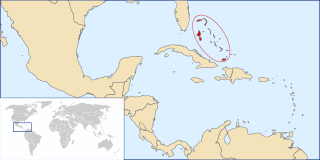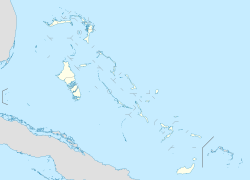
The Bahamas, officially the Commonwealth of The Bahamas, is an island country within the Lucayan Archipelago of the Atlantic Ocean. It contains 97% of the Lucayan Archipelago's land area and 88% of its population. The archipelagic country consists of more than 3,000 islands, cays, and islets in the Atlantic Ocean, and is located north of Cuba and northwest of the island of Hispaniola and the Turks and Caicos Islands, southeast of the U.S. state of Florida and east of the Florida Keys. The capital is Nassau on the island of New Providence. The Royal Bahamas Defence Force describes the Bahamas' territory as encompassing 470,000 km2 (180,000 sq mi) of ocean space.

The economy of the Bahamas is dependent upon tourism and offshore banking. The Bahamas is the richest country in the West Indies and is ranked 14th in North America for nominal GDP. It is a stable, developing nation in the Lucayan Archipelago, with a population of 391,232 (2016). Steady growth in tourism receipts and a boom in construction of new hotels, resorts, and residences had led to solid GDP growth for many years. The slowdown in the Economy of the United States and the September 11 attacks held back growth in these sectors from 2001 to 2003.
This article talks about transportation in the Bahamas, a North American archipelagic state in the Atlantic Ocean.
The Lucayan people were the original residents of The Bahamas and the Turks and Caicos Islands before the European colonisation of the Americas. They were a branch of the Taínos who inhabited most of the Caribbean islands at the time. The Lucayans were the first Indigenous Americans encountered by Christopher Columbus. Shortly after contact, the Spanish kidnapped and enslaved Lucayans with the displacement culminating in the complete eradication of the Lucayan people from the Bahamas by 1520.

Andros Island is an archipelago within The Bahamas, the largest of the Bahamian Islands. Politically considered a single island, Andros in total has an area greater than all the other 700 Bahamian islands combined. The land area of Andros consists of hundreds of small islets and cays connected by mangrove estuaries and tidal swamplands, together with three major islands: North Andros, Mangrove Cay, and South Andros. The three main islands are separated by bights, estuaries that trifurcate the island from east to west. It is 167 kilometres (104 mi) long by 64 km (40 mi) wide at the widest point.

The Abaco Islands lie in the north of The Bahamas, about 193 miles east of Miami, Florida, US. The main islands are Great Abaco and Little Abaco, which is just west of Great Abaco's northern tip. There are several smaller barrier cays, of which the northernmost are Walker's Cay and its sister island Grand Cay. To the south, the next inhabited islands are Spanish Cay and Green Turtle Cay, with its settlement of New Plymouth, Great Guana Cay, private Scotland Cay, Man-O-War Cay and Elbow Cay, with its settlement of Hope Town. Southernmost are Tilloo Cay and Lubbers Quarters. Also of note off Abaco's western shore is Gorda Cay, now a Disney-owned island and cruise ship stop renamed Castaway Cay. Also in the vicinity is Moore's Island. On the Big Island of Abaco is Marsh Harbour, the Abacos' commercial hub and The Bahamas' third-largest city, plus the resort area of Treasure Cay. Both have airports. Mainland settlements include Coopers Town and Fox Town in the north and Cherokee and Sandy Point in the south. Administratively, the Abaco Islands constitute seven of the 31 Local Government Districts of The Bahamas: Grand Cay, North Abaco, Green Turtle Cay, Central Abaco, South Abaco, Moore's Island and Hope Town.

Grand Bahama is the northernmost of the islands of The Bahamas, with the town of West End located 56 nautical miles east of Palm Beach, Florida. It is the third largest island in The Bahamas island chain of approximately 700 islands and 2,400 cays. The island is roughly 530 square miles (1,400 km2) in area and approximately 153 kilometres long west to east and 24 kilometres at its widest point north to south. Administratively, the island consists of the Freeport Bonded Area and the districts of East Grand Bahama and West Grand Bahama. Nearly half of the homes on the island were damaged or destroyed in early September 2019 by Hurricane Dorian.

Freeport is a city, district and free trade zone on the island of Grand Bahama of the northwest part of The Bahamas. In 1955, Wallace Groves, a Virginian financier with lumber interests in Grand Bahama, was granted 20,000 hectares of pineyard with substantial areas of swamp and scrubland by the Bahamian government with a mandate to economically develop the area. Freeport has grown to become the second most populous city in The Bahamas.

Exuma is a district of The Bahamas, consisting of over 365 islands and cays.

Mayaguana is the easternmost island and district of The Bahamas. Its population was 277 in the 2010 census. It has an area of about 280 km2 (110 sq mi).

Sir Stafford Lofthouse Sands was a former Minister of Finance of the Bahamas (1964–1967), who held other high positions in the islands until his self-chosen exile in 1967. Hailed as Father of Tourism, he succumbed to corruption, allowing organized crime to unfold activities like money laundering and to establish offshore banking on the Bahamas.

West Grand Bahama is one of 31 districts of The Bahamas. The district covers the entire western portion of Grand Bahama island, excluding the city of Freeport, which forms its own district. Communities within West Grand Bahama include the settlements of Mack Town, Hunters, Lewis Yard, Pinder's Point, Eight Mile Rock, Hepburn Town, Bartlett Hill, Hanna Hill, Pine Dale, Martin Town, Russell Town, Jones Town, Sea Grape, Holmes Rock, Bootle Bay and the westernmost settlement of West End.
Grand Bahama International Airport (GBIA) is an international airport in Freeport, The Bahamas. It was privately owned until the government of The Bahamas purchased it in April 29 2021 for one Bahamian dollar, a deal they were able to procure largely due to the devastation from Hurricane Dorian, which almost completely destroyed the airport in 2019. The Bahamian government spent a approximately $1 million on staff severance costs as part of the deal.

The following outline is provided as an overview of and topical guide to The Bahamas:

Walker's Cay is the northernmost island in the Bahamas, part of the North Abaco district. Once a popular sport fishing location, the island was left deserted after 2004, following severe hurricane damage. The island is currently undergoing renovation under new owner Carl Allen, and celebrated the grand reopening of its marina in 2021.
West End Airport is an airport that serves Grand Bahama. While smaller than the other airport on the island located in Freeport, this airport has a paved runway 7,999 feet in length as well as onsite customs and immigration. This airport currently serves private planes and charters. The airport features the westernmost runway in the entire Bahamian archipelago.

The following is an alphabetical list of topics related to the Commonwealth of The Bahamas.

The Bahamian pineyards are a tropical and subtropical coniferous forest ecoregion in the Bahamas and the Turks and Caicos Islands.
Bahamian cuisine refers to the foods and beverages of The Bahamas. It includes seafood such as fish, shellfish, lobster, crab, and conch, as well as tropical fruits, rice, peas, pigeon peas, and pork. Popular seasonings commonly used in dishes include chilies, lime, tomatoes, onions, garlic, allspice, ginger, cinnamon, rum, and coconut. Rum-based beverages are popular on the islands. Since the Bahamas consist of a multitude of islands, notable culinary variations exist.
Midet Aviation was a small US international airline certificated to fly between south Florida and West End on Grand Bahama Island by the Civil Aeronautics Board (CAB), the now-defunct Federal agency that at the time tightly regulated almost all US commercial air transportation. Midet's fate was tied to the progress of tourist facilities on Grand Bahama Island, which prior to the 1950s were limited. An enormous resort was constructed at West End from nothing, but then abandoned, only partially complete, after one season, crimping Midet's prospects. Meanwhile, Mackey Airlines, which the CAB had also certificated to fly from South Florida to elsewhere in the Bahamas, did better. It made sense to fold subscale Midet into Mackey, which occurred in 1956.














